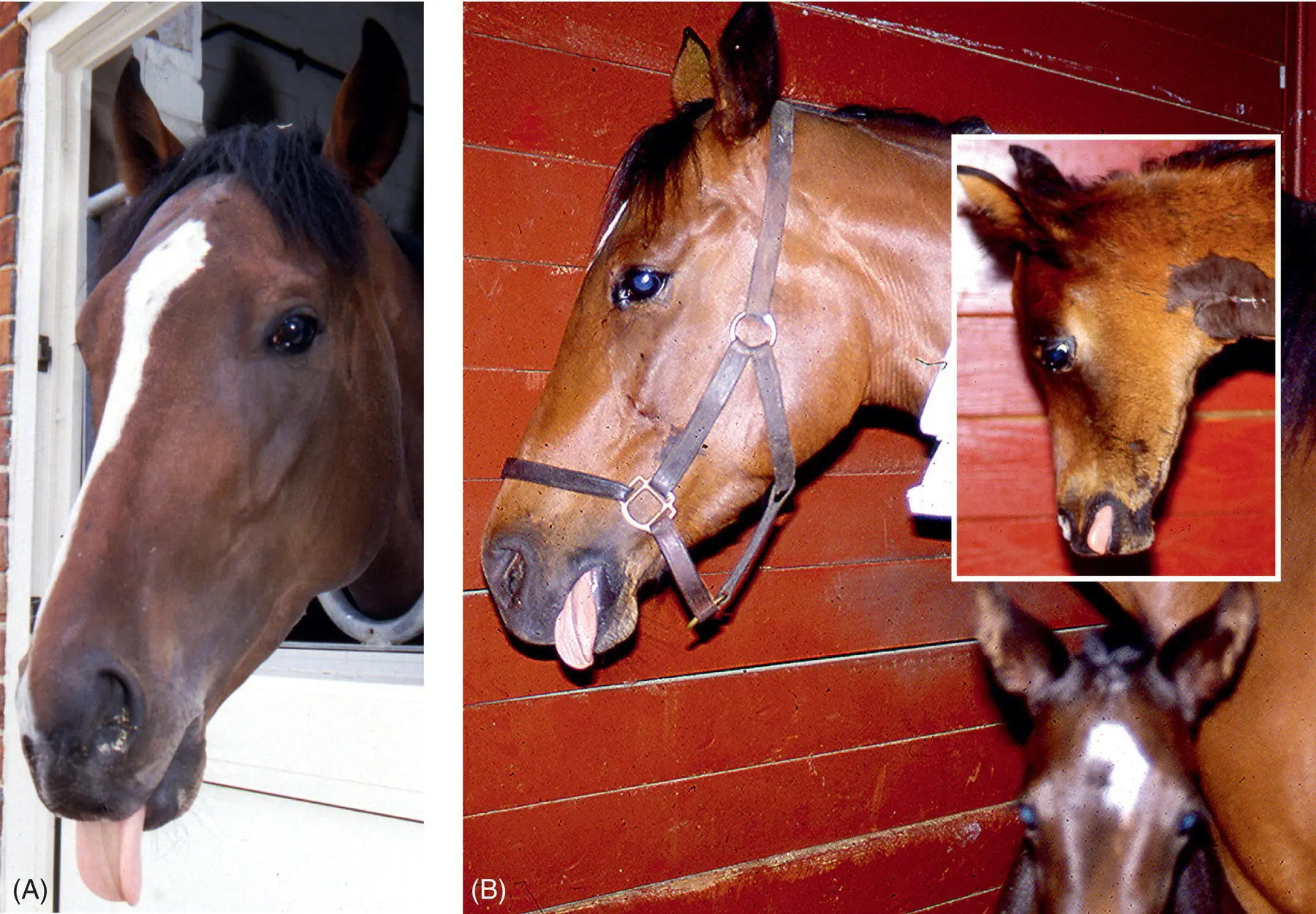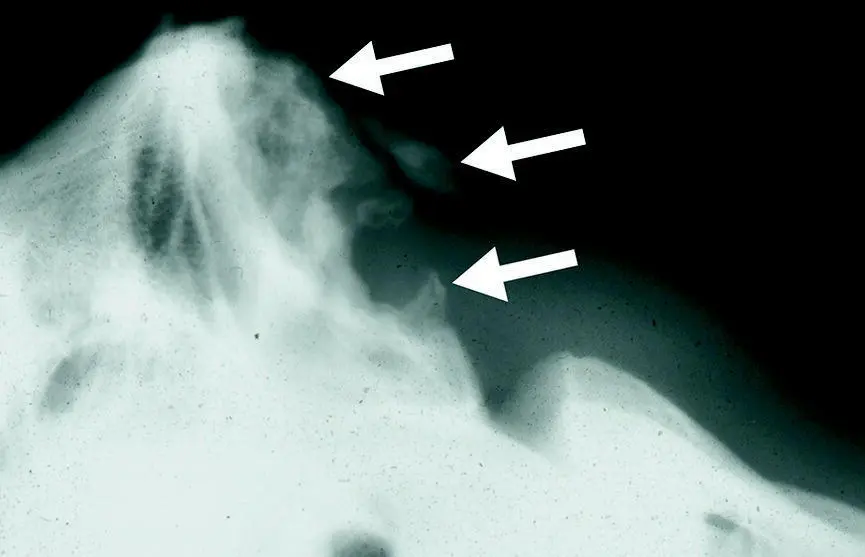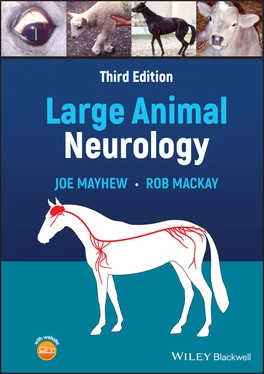
Figure 5.5 Painful processes, perhaps especially abdominal pain, frequently cause unexpected and abnormal behavior in large animals frequently, and such actions need to be distinguished from those caused by morbid neurologic diseases. This racehorse would unexpectedly rear uncontrollably while being walked. There were no other signs of brain abnormalities, and the only lesions detected clinically were focal, suppurative pleuritis and pneumonia from which he recovered with appropriate treatment.

Figure 5.6 The Thoroughbred racehorse shown here (A) is a tongue sucker and demonstrated this stereotypic behavior frequently. The horse appeared to appreciate having its tongue grasped and manipulated, and such a maneuver would set off an episode of the tongue‐sucking behavior shown. The mare (B) also demonstrates this behavior. Her healthy newborn foal accompanied her into the hospital and within days was seen to demonstrate the same repetitive and nonproductive behavior (inset).

Figure 5.7 Horses diagnosed as headshakers usually have little else in the way of physical and neurologic signs. They usually display the syndrome best during some form of movement or exercise such as this Clydesdale gelding (A) and gray Thoroughbred mare (B) while being lunged. In addition to the dorsoventral and sometimes lateral flicking movements of the head on the neck, some will repeatedly snort and attempt to rub their nasal region on the ground (B) or forelimbs while moving to cover their distal face with dirt (inset). The syndrome is aptly explained by the adage “acting as if it has a bee up its nose.” Riding becomes dangerous or impossible with severe cases. After demonstrating the signs, some horses will rub their muzzle and face on objects.

Figure 5.8 Radiographs of the atlantooccipital region of a horse demonstrating headshaking. There is marked modeling of the caudal aspect of the occipital protuberance (arrows). This riding horse would only perform persistent dorsoventral head movements while fully tacked‐up with a bridle for ridden work. Local anesthetic solution deposited around the region of bone modeling almost stopped the syndrome occurring for about an hour, and infiltrating a repository glucocorticoid drug in the region attenuated the syndrome markedly for over a week. Ultimately, surgical exploration and removal of much of the new mineralized tissue was undertaken, and after healing of the surgical site the syndrome did not occur while the horse was ridden for several months before the case was lost to follow‐up. It is however worth recalling that horses without the problem of headshaking can have various radiographic changes present in this region (see Figure 3.9).
Quite bizarre syndromes can be seen as idiosyncratic reactions to intramuscular injections of depot forms of antipsychotic drugs including fluphenazine used for chronic sedation and sulpiride used for lactation induction protocol. Included in these can be episodes of unusual, monotonous movements of the limbs and of the head and neck with the thoracic limbs extended and the head touching the ground—even flexed between them in a “praying” posture. 2Episodes of bradykinesia or freezing can also occur. Such signs can be interrupted by unpredictable, violent events that render the situation dangerous although most cases have responded to anticholinergic therapy with diphenhydramine and/or benztropine. 3These syndromes can be compared to the extrapyramidal side effects seen in people with antipsychotic and antidopaminergic drugs including fluphenazine and metoclopramide, but they can also occur in animals suffering from brain injury and from meningitis.
With no other neurologic signs, it can be difficult to be sure whether subtle behavioral syndromes are learned repetitive behavioral traits—or simply actions perceived as being unacceptable responses to human‐induced management restrictions placed on domestic animals rather than being due to acquired morbid neurologic lesions. Examples of these include repetitive licking and sucking ( Figure 5.6), head shaking ( Figures 5.7and 5.8), tail wringing, aggressiveness, self‐mutilation, and refusing to follow learned instructions such as taking jumps. Some of these syndromes are discussed in Chapter 28, although for a more detailed evaluation of equine behavioral aberrations, the reader is directed to further literature. 4–15Although tempting to speculate, there is not ample evidence that many forms of varied behavior, regarded as unacceptable in domesticated animals by humans, are genetic for the most part, 16and indeed many clinicians would rather suggest they are acquired, even when appearing in successive offspring.
Finally, the potential role of painful sensory inflammatory or degenerative lesions such as ganglioneuritis 17in causing unacceptable and dangerous behavior needs further ratification.
1 1 Couetil LL and Hoffman AM. Adrenal insufficiency in a neonatal foal. J Am Vet Med Assoc 1998; 212(10): 1594–1596.
2 2 McCrindle CM, Ebedes H and Swan GE. The use of long‐acting neuroleptics, perphenazine enanthate and pipothiazine palmitate in two horses. J S Afr Vet Assoc 1989; 60(4): 208–209.
3 3 Baird JD, Arroyo LG, Vengust M, et al. Adverse extrapyramidal effects in four horse given fluphenazine decanoate. J Am Vet Med Assoc 2006; 229(1): 104–110.
4 4 Crowell‐Davis SL and Houpt KA. Behavior. Vet Clin North Am Eq Pract 1986; 2: 465–671.
5 5 Hahn CN. Behavior and the Brain. In Equine Behavior: A Guide for Veterinarians and Equine Scientists, McGreevy P, Editor. Saunders, Philadelphia, PA. 2004.
6 6 Kiley‐Worthington M. Stereotypes in horses. Cause, function and prevention. Equine Pract 1983; 5(1): 33–40.
7 7 Kiley‐Worthington M, Wood‐Gush D. Stereotypic Behavior, in Current Therapy in Equine Medicine, Robinson NE, Editor. 2nd ed. Philadelphia. 1987; 131–134.
8 8 Beaver BV. Aggressive behavior problems. Vet Clin North Am Equine Pract. 1986; 2(3): 635–644.
9 9 Houpt KA. New perspectives on equine stereotypic behavior. Equine Vet Educ 1995; 27(2): 82–83.
10 10 Luescher UA. Porcine behavior problems. Comp Cont Edu Pract Vet 1998; 11: 515–518.
11 11 McGreevy P. Equine Behavior: A Guide for Veterinarians and Equine Scientists. Saunders, Philadelphia, PA. 2004; 369.
12 12 Price EO. Farm animal behavior. Vet Clin North Am Food Anim Pract 1987; 3: 217–481.
13 13 McGreevy PD, French NP and Nicol CJ. The prevalence of abnormal behaviours in dressage, eventing and endurance horses in relation to stabling. Vet Rec 1995; 137(2): 36–37.
14 14 McAfee LM, Mills DS and Cooper JJ. The use of mirrors for the control of stereotypic weaving behaviour in the stabled horse. Appl Anim Behav Sci 2002; 78(2–4): 159–173.
15 15 Houpt KA. Domestic Animal Behavior for Veterinarians and Animal Scientists. 6th ed. Wiley‐Blackwell, Hoboken, NJ. 2018; 448.
16 16 Hemmann K, Ahonen S, Raekallio M, Vainio O and Lohi H. Exploration of known stereotypic behaviour‐related candidate genes in equine crib‐biting. Animal 2014; 8(3): 347–353.
Читать дальше
















